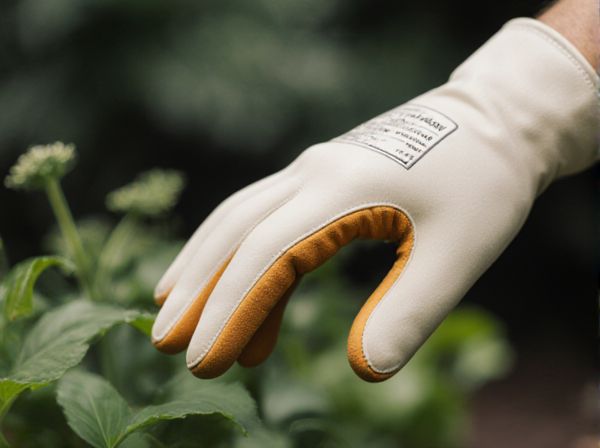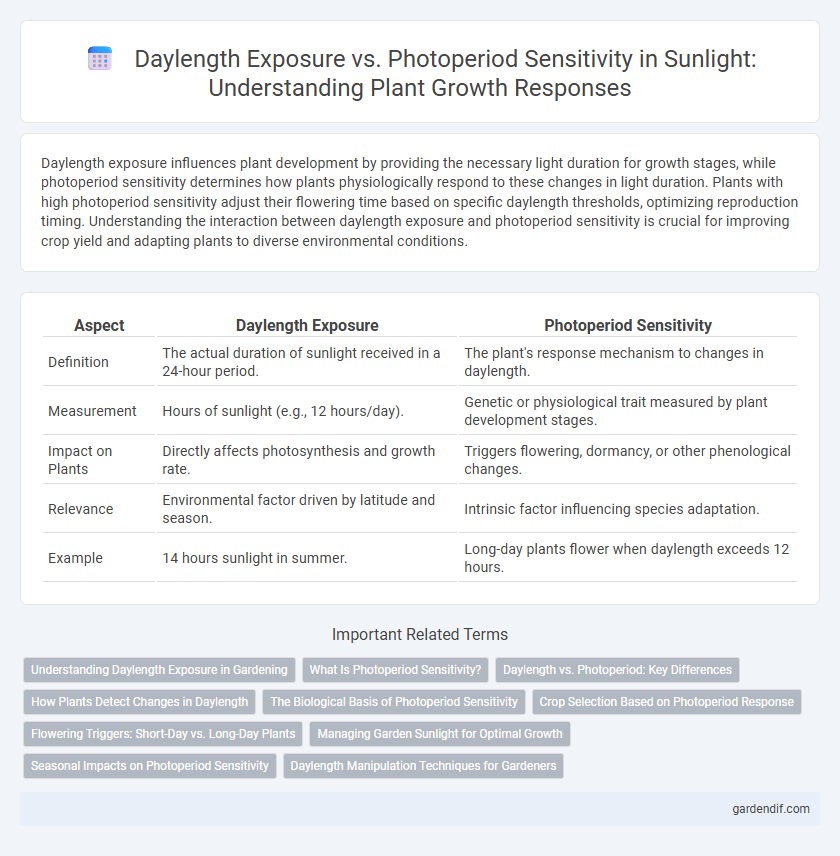
Daylength exposure vs photoperiod sensitivity Illustration
Daylength exposure influences plant development by providing the necessary light duration for growth stages, while photoperiod sensitivity determines how plants physiologically respond to these changes in light duration. Plants with high photoperiod sensitivity adjust their flowering time based on specific daylength thresholds, optimizing reproduction timing. Understanding the interaction between daylength exposure and photoperiod sensitivity is crucial for improving crop yield and adapting plants to diverse environmental conditions.
Table of Comparison
| Aspect | Daylength Exposure | Photoperiod Sensitivity |
|---|---|---|
| Definition | The actual duration of sunlight received in a 24-hour period. | The plant's response mechanism to changes in daylength. |
| Measurement | Hours of sunlight (e.g., 12 hours/day). | Genetic or physiological trait measured by plant development stages. |
| Impact on Plants | Directly affects photosynthesis and growth rate. | Triggers flowering, dormancy, or other phenological changes. |
| Relevance | Environmental factor driven by latitude and season. | Intrinsic factor influencing species adaptation. |
| Example | 14 hours sunlight in summer. | Long-day plants flower when daylength exceeds 12 hours. |
Understanding Daylength Exposure in Gardening
Daylength exposure significantly influences plant growth by affecting photosynthesis rates and developmental cycles. In gardening, understanding photoperiod sensitivity--plants' response to the relative lengths of day and night--helps optimize planting schedules and crop yield. Adjusting garden routines based on daylength exposure enhances flowering, fruiting, and overall plant health.
What Is Photoperiod Sensitivity?
Photoperiod sensitivity refers to an organism's response to the length of daylength exposure, which influences key biological processes such as flowering in plants and breeding cycles in animals. Unlike general daylength exposure, photoperiod sensitivity is determined by genetic and molecular mechanisms that detect specific durations of light and darkness, triggering developmental changes. Understanding photoperiod sensitivity is crucial for optimizing agricultural practices and managing ecosystems affected by seasonal sunlight variations.
Daylength vs. Photoperiod: Key Differences
Daylength refers to the actual duration of sunlight exposure in a 24-hour period, whereas photoperiod sensitivity describes an organism's biological response to changes in daylength. Plants and animals with high photoperiod sensitivity adjust their physiological activities like flowering or breeding based on specific daylight thresholds. Understanding these differences is crucial for optimizing agriculture and ecological research, as daylength affects environment cues while photoperiod sensitivity governs adaptive behavior.
How Plants Detect Changes in Daylength
Plants detect changes in daylength through photoreceptors such as phytochromes and cryptochromes that measure the duration of light and darkness, enabling the calculation of critical photoperiod thresholds. These photoreceptors trigger molecular pathways regulating flowering time and other developmental processes by sensing the length of uninterrupted darkness. The integration of light signals with the circadian clock adjusts gene expression patterns, allowing plants to respond adaptively to seasonal variations in sunlight exposure.
The Biological Basis of Photoperiod Sensitivity
Photoperiod sensitivity is genetically controlled through the regulation of circadian clock genes that respond to changes in daylength, enabling organisms to time developmental processes such as flowering or reproduction. Variations in gene expression triggered by the duration of light exposure influence hormone levels, particularly phytochromes and florigen, which act as signaling molecules in photoperiodic pathways. This biological mechanism allows plants and animals to adapt to seasonal changes by synchronizing their physiological activities with environmental light cycles.
Crop Selection Based on Photoperiod Response
Crop selection based on photoperiod response is critical for optimizing growth and yield, as daylength exposure directly influences flowering time and developmental stages in many species. Plants classified as short-day, long-day, or day-neutral exhibit varying sensitivities to photoperiod, dictating their suitability for specific geographic regions and planting seasons. Understanding these photoperiod sensitivity patterns enables agronomists and farmers to match crop varieties with local daylength conditions, maximizing productivity and resource efficiency.
Flowering Triggers: Short-Day vs. Long-Day Plants
Daylength exposure directly influences photoperiod sensitivity, determining flowering triggers in plants. Short-day plants initiate flowering when daylight falls below a critical threshold, while long-day plants flower when daylength exceeds this limit. Understanding these mechanisms is essential for optimizing crop yields by aligning planting schedules with natural photoperiods.
Managing Garden Sunlight for Optimal Growth
Daylength exposure influences plant physiological processes by regulating photosynthesis and hormonal activity, while photoperiod sensitivity determines a plant's developmental response to varying light durations. Managing garden sunlight effectively requires selecting species with compatible photoperiodic traits and timing light exposure to align with their growth cycles. Utilizing shade structures or reflective surfaces optimizes available sunlight, enhancing growth rates and flowering in photoperiod-sensitive plants.
Seasonal Impacts on Photoperiod Sensitivity
Seasonal changes in daylength exposure directly influence photoperiod sensitivity, affecting plant growth and flowering times. Longer daylight during spring and summer triggers photoreceptors, modulating gene expression that controls developmental phases. Variations in photoperiod sensitivity among species determine adaptation to shifting seasonal light conditions, impacting agricultural productivity and ecosystem dynamics.
Daylength Manipulation Techniques for Gardeners
Daylength manipulation techniques enable gardeners to control plant growth by adjusting exposure to natural or artificial light, optimizing flowering and fruiting cycles based on specific photoperiod sensitivity. Methods such as using blackout curtains to shorten daylight or supplemental lighting to extend photoperiods enhance plant development by simulating ideal daylength conditions. Strategic control of daylength exposure influences hormonal responses in plants, facilitating precise management of flowering time, yield, and overall crop quality.
Daylength exposure vs photoperiod sensitivity Infographic

 gardendif.com
gardendif.com